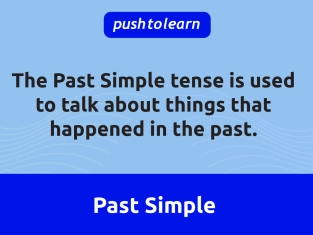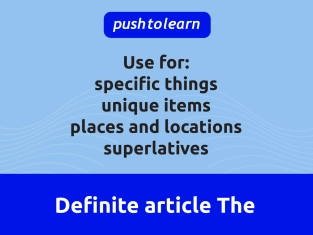by PushtoLearn
Prepositions of Place
Table of Contents
In, On, at, Under, Next to, Between, Behind, and Above – Prepositions of Place - Exercises
These exercises focus on prepositions of place AT, IN and ON
1. In
In is used to show that something is inside an enclosed space or area.
Examples:
-
"The cat is in the box." (inside the box)
-
"She’s studying in the library." (inside a building)
-
"They live in New York." (inside a city)
Use in for:
-
Enclosed spaces (rooms, buildings)
-
Large areas (cities, countries, neighborhoods)
-
Vehicles like cars or taxis (e.g., "They’re in a taxi.")

2. On
On is used when something is on top of a surface or touching it.
Examples:
-
"The book is on the table." (on top of the table)
-
"He wrote a note on the whiteboard." (on the surface of the whiteboard)
-
"They live on Maple Street." (on a street)
Use on for:
-
Surfaces (tables, walls, floors)
-
Means of public transportation (buses, trains, planes)
-
Streets (e.g., "They live on Main Street.")
3. At
At is used to indicate a specific point or location.
Examples:
-
"I’ll meet you at the bus stop." (specific point)
-
"She is at the front door." (specific location)
-
"They are at the party." (specific event)
Use at for:
-
Specific points or places (bus stops, addresses with numbers)
-
Public places (schools, airports, workplaces)
-
Events (parties, concerts)
4. Under
Under is used to show that something is below or beneath something else.
Examples:
-
"The dog is under the table." (below the table)
-
"I found the keys under the couch." (beneath the couch)
-
"The umbrella is under the chair." (below the chair)
Use under for:
-
When one object is directly below another.
5. Above
Above means that something is higher than something else, but not necessarily directly over it.
Examples:
-
"The clock is above the door." (higher than the door)
-
"Planes fly above the clouds." (higher than the clouds)
-
"The picture is above the sofa." (higher than the sofa)
Use above for:
-
Anything higher than an object, not directly over it.
6. Next to / Beside
Next to or beside is used to show that something is immediately at the side of something else.
Examples:
-
"She is sitting next to her friend." (immediately beside her friend)
-
"The bank is next to the grocery store." (at the side of the grocery store)
-
"There’s a lamp beside the bed." (right at the side of the bed)
Use next to / beside for:
-
Things that are directly at the side of another object or person.
7. Between
Between is used to show that something is in the middle of two other things.
Examples:
-
"The park is between the library and the school." (in the middle of two places)
-
"She is sitting between her two friends." (in the middle of two people)
-
"The bridge is between the river banks." (in the middle of two sides of the river)
Use between for:
-
An object or person located in the middle of two other things.
8. In Front of
In front of means that something is ahead of or facing something else.
Examples:
-
"The car is parked in front of the house." (ahead of the house)
-
"She is standing in front of the classroom." (facing the classroom)
-
"The teacher stood in front of the students." (ahead of the students)
Use in front of for:
-
Something located ahead of another object or facing it.
9. Behind
Behind is used to show that something is at the back of or hidden by something else.
Examples:
-
"The child is hiding behind the tree." (at the back of the tree)
-
"The house is behind the hill." (at the back of the hill)
-
"The chair is behind the desk." (at the back of the desk)
Use behind for:
-
Anything positioned at the back of another object.
10. Near / Close to
Near or close to is used to show that something is not far from another thing.
Examples:
-
"The school is near the library." (not far from the library)
-
"They live close to the beach." (not far from the beach)
-
"The park is near our house." (not far from the house)
Use near / close to for:
-
When two things are close by but not necessarily touching.
It may also be useful to learn This, That, These, Those and At, In, On – Prepositions of Timeto be able to describe something specific in our surroundings and time of events.
Summary Table of Prepositions of Place
|
Preposition |
Meaning |
Example |
|
In |
Inside an enclosed area |
"The cat is in the box." |
|
On |
On top of a surface |
"The keys are on the table." |
|
At |
Specific point or location |
"I’ll meet you at the bus stop." |
|
Under |
Below or beneath |
"The shoes are under the bed." |
|
Above |
Higher than, not touching |
"The clock is above the door." |
|
Next to / Beside |
At the side of |
"The chair is next to the desk." |
|
Between |
In the middle of two things |
"The park is between two buildings." |
|
In front of |
Ahead of or facing |
"The car is in front of the house." |
|
Behind |
At the back of |
"The dog is behind the couch." |
|
Near / Close to |
Not far from |
"She lives near the school." |
Example Sentences Using Prepositions of Place
-
"The lamp is on the nightstand next to the bed."
-
"The children are playing in the park behind the school."
-
"I’ll wait for you at the entrance in front of the building."
-
"The restaurant is between the bank and the pharmacy."
-
"They parked their bikes near the entrance."
FAQ
What’s the difference between "in" and "on"?
In is used for enclosed spaces, like rooms or cities (e.g., "in the car"), while on is used for surfaces or streets (e.g., "on the table").
When should I use "at" instead of "in" or "on"?
Use at when talking about specific points, like an address or a location where an activity happens (e.g., "at the office," "at the door").
How is "under" different from "below"?
Under is directly beneath something, while below is just lower than something (not necessarily directly beneath it).
Can "near" and "next to" be used interchangeably?
Not exactly. Next to means right beside, while near means close by, but not necessarily right beside.
Can I use "between" for more than two things?
Between is usually used for two things. For three or more, use among (e.g., "among friends").

